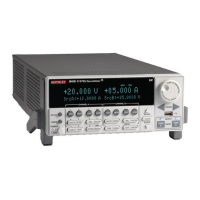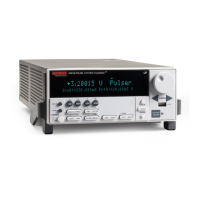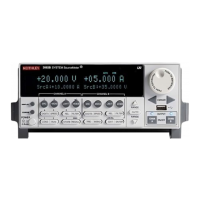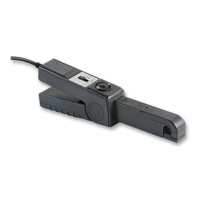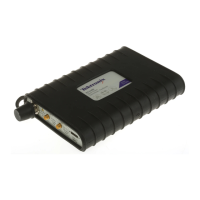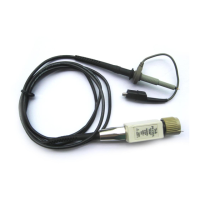High Voltage SourceMeter Instrument Reference Manual Section 4:
2470-901-01 Rev. A / May 2019 4-35
Using SCPI commands:
Send the :SOURce:VOLTage:PROTection command with the value of the limit. For example, to set
the overvoltage limit for the voltage source to 20 V, send the command:
SOURce:VOLTage:PROTection PROT20
See the command description for :SOURce[1]:<function>:PROTection[:LEVel] (on page 12-80) for the
full list of options.
Using TSP commands:
Set the source function and send the smu.source.protect.level command with the value of t
he
l
imit. For example, to set the overvoltage limit to 20 V for the voltage source function, send the
commands:
smu.source.func = smu.FUNC_DC_VOLTAGE
smu.source.protect.level = smu.PROTECT_20V
See the command description for smu.source.protect.level (on page 14-164) for the full list of options.
Source limits
The source limits (also known as compliance) prevent the instrument from sourcing a voltage or
current over a set value. This helps prevent damage to the device under test (DUT).
The values that can be set for the limits must be below the setting for the overvoltage protection limit.
This limit can also be restricted by the measurement range. If a specific measurement range is set,
the limit must be more than 0.1 percent of the measurement range. If not, an event is generated and
the limit is automatically changed to an appropriate value for the selected range. If you set the
measurement range to be automatically selected, the measurement range does not affect the limit.
If you attempt to change the source limit to a value that is not appropriate for the selected source
range, the source limit is not changed and a warning is generated. You must change the source
range before you can select the new limit.
The lowest allowable limit is based on the load and the source value. For example, if you are sourcing
1 V to a 1 kΩ resistor, the lowest allowable current limit is 1 mA (1 V/1 kΩ = 1 mA). Setting a limit
lower than 1 mA limits the source.
For example, assume the following conditions:
• Current limit 10 mA
• Instrument sources a voltage of 10 V
• DUT resistance of 10 Ω
With a source voltage of 10 V and a DUT resistance of 10 Ω, the current through the DUT should be:
10 V / 10 Ω = 1 A. However, because the limit is set to 10 mA, the current will not exceed 10 mA, and

